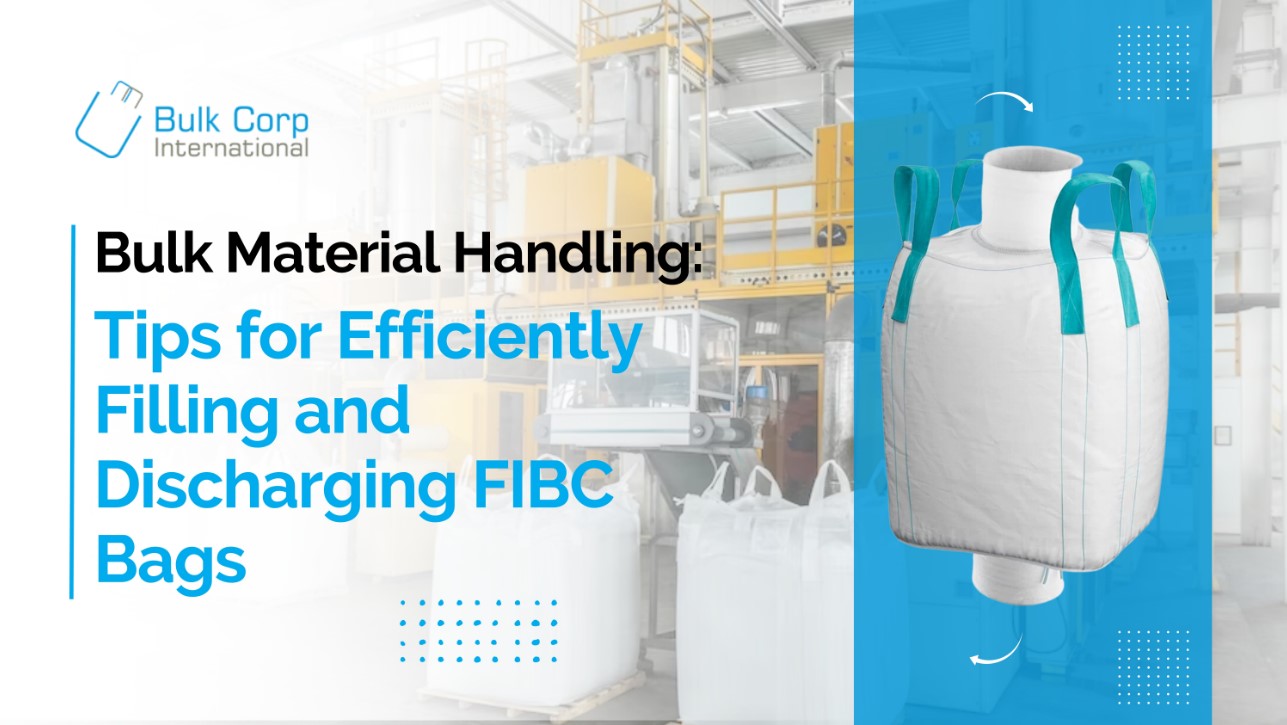Bulk Material Handling: Tips for Efficiently Filling and Discharging FIBC Bags

In modern-day packaging options, FIBC bags have stamped their impression as the most versatile, durable, reliable, and cost-effective packaging solution. FIBC bag customization enables users to choose from various opening and bottom options for an efficient filling and discharging process.
For instance, a spout bottom is ideal for streamlining the emptying of powdery substances and minerals. Full Drop Bottom is suitable for discharging agricultural produce, such as maize and barley.
It’s pivotal to understand the best practices for filling and discharging FIBC bags to ensure a smooth and efficient process. In this blog, we’ll explore vital tips to help you handle these bags efficiently during the filling and discharge.
Critical Points to Remember While Filling FIBC Bags
Check Bag Integrity
Before filling, inspect the FIBC for any damage, such as tears, cuts, or loose threads. Ensure that it meets the safety standards and specifications required for your application.
Proper Positioning
Position the FIBC bag on a flat and stable surface, ensuring it won’t tip or collapse during filling.
Correctly Calculate Material
Accurately calculate and measure the quantity of material to be loaded into the FIBC bag. Avoid overfilling, as it can damage the bag and spill its contents.
Use a Spout or Funnel
For powdery or fine materials, use a spout or funnel to drive the material into the bag’s inlet. It mitigates spillage and makes the filling process more precise.
Control Dust
If your fine products generate dust during filling, consider using dust control measures such as dust collection systems or anti-dust additives.
Salient Points to Remember While Discharging FIBC Bags
Position Properly
Place the FIBC bag in the desired discharging location, ensuring it’s stable and secure. Use appropriate handling equipment like forklifts, cranes, or discharge frames.
Select the Right Discharge Outlet
Determine the most suitable discharge doorway for your material. FIBC bags offer different types of emptying options, including spouts, cones, or flap closures.
Cutting Techniques
If your FIBC bag has a spout, use a clean and controlled cutting technique to open it. Avoid sharp tools or excessive force that may damage the bag or cause spillage.
Use Gravity and Vibration
To ensure complete material discharge, use gravity by elevating one side of the bag or by providing gentle vibrations for smooth product flow inside the bag.
Monitor Flow
Keep a close eye on the material discharge to prevent blockages or uneven flow. Adjust the bag’s position or use additional equipment if necessary.
Safety Measures
Always follow safety protocols during the discharging process to protect personnel and prevent accidents. Ensure adequate ventilation if dealing with potentially hazardous materials.
Clean-Up
After discharging, clean the FIBC bag thoroughly to remove any remaining material. Properly dispose of any residue in accordance with local regulations.
Conclusion
Efficiently filling and discharging FIBC bags is paramount to maximize productivity and minimize material wastage or spillage. By following these tips and adhering to safety guidelines, you can ensure a smooth and reliable process, whether working with powders, granules, or other bulk materials.
At Bulkcorp International, we manufacture customized FIBC Bulk Bags. We give clients options to select the top and closure options best suited for their applications.
For any questions or a quotation, contact us at +91-79-29795319 or email info@bulkcorp-int.com. Our sales experts will provide sound guidance and transparent pricing.





